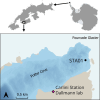Manganese reduction and associated microbial communities in Antarctic surface sediments
- PMID: 39021633
- PMCID: PMC11252027
- DOI: 10.3389/fmicb.2024.1398021
Manganese reduction and associated microbial communities in Antarctic surface sediments
Abstract
The polar regions are the fastest warming places on earth. Accelerated glacial melting causes increased supply of nutrients such as metal oxides (i.e., iron and manganese oxides) into the surrounding environment, such as the marine sediments of Potter Cove, King George Island/Isla 25 de Mayo (West Antarctic Peninsula). Microbial manganese oxide reduction and the associated microbial communities are poorly understood in Antarctic sediments. Here, we investigated this process by geochemical measurements of in situ sediment pore water and by slurry incubation experiments which were accompanied by 16S rRNA sequencing. Members of the genus Desulfuromusa were the main responder to manganese oxide and acetate amendment in the incubations. Other organisms identified in relation to manganese and/or acetate utilization included Desulfuromonas, Sva1033 (family of Desulfuromonadales) and unclassified Arcobacteraceae. Our data show that distinct members of Desulfuromonadales are most active in organotrophic manganese reduction, thus providing strong evidence of their relevance in manganese reduction in permanently cold Antarctic sediments.
Keywords: Antarctic; Arcobacteraceae; Desulfuromusa; Potter Cove; Sva1033; manganese reduction; marine surface sediment; organic carbon degradation.
Copyright © 2024 Wunder, Breuer, Willis-Poratti, Aromokeye, Henkel, Richter-Heitmann, Yin and Friedrich.
Conflict of interest statement
The authors declare that the research was conducted in the absence of any commercial or financial relationships that could be construed as a potential conflict of interest. The author(s) declared that they were an editorial board member of Frontiers, at the time of submission. This had no impact on the peer review process and the final decision.
Figures




Similar articles
-
Macroalgae degradation promotes microbial iron reduction via electron shuttling in coastal Antarctic sediments.Environ Int. 2021 Nov;156:106602. doi: 10.1016/j.envint.2021.106602. Epub 2021 May 26. Environ Int. 2021. PMID: 34051435
-
Iron and sulfate reduction structure microbial communities in (sub-)Antarctic sediments.ISME J. 2021 Dec;15(12):3587-3604. doi: 10.1038/s41396-021-01014-9. Epub 2021 Jun 21. ISME J. 2021. PMID: 34155335 Free PMC article.
-
Spatial variability of biogeochemistry in shallow coastal benthic communities of Potter Cove (Antarctica) and the impact of a melting glacier.PLoS One. 2018 Dec 19;13(12):e0207917. doi: 10.1371/journal.pone.0207917. eCollection 2018. PLoS One. 2018. PMID: 30566444 Free PMC article.
-
Pelagic and benthic communities of the Antarctic ecosystem of Potter Cove: Genomics and ecological implications.Mar Genomics. 2017 Jun;33:1-11. doi: 10.1016/j.margen.2017.05.001. Epub 2017 May 4. Mar Genomics. 2017. PMID: 28479280 Review.
-
Marine pelagic ecosystems: the west Antarctic Peninsula.Philos Trans R Soc Lond B Biol Sci. 2007 Jan 29;362(1477):67-94. doi: 10.1098/rstb.2006.1955. Philos Trans R Soc Lond B Biol Sci. 2007. PMID: 17405208 Free PMC article. Review.
Cited by
-
Metal Mobilization from Thawing Permafrost Is an Emergent Risk to Water Resources.ACS ES T Water. 2024 Dec 10;5(1):20-32. doi: 10.1021/acsestwater.4c00789. eCollection 2025 Jan 10. ACS ES T Water. 2024. PMID: 39816976 Free PMC article. Review.
-
New horizons in microbial fuel cell technology: applications, challenges, and prospects.Biotechnol Biofuels Bioprod. 2025 Jul 18;18(1):79. doi: 10.1186/s13068-025-02649-y. Biotechnol Biofuels Bioprod. 2025. PMID: 40682119 Free PMC article. Review.
-
Bacterial community composition and function in different habitats in Antarctic Fildes region revealed by high-throughput sequencing.Front Microbiol. 2025 Jun 16;16:1524681. doi: 10.3389/fmicb.2025.1524681. eCollection 2025. Front Microbiol. 2025. PMID: 40589579 Free PMC article.
References
-
- Algora C., Gründger F., Adrian L., Damm V., Richnow H.-H., Krüger M. (2013). Geochemistry and microbial populations in sediments of the northern Baffin Bay, Arctic. Geomicrobiol J. 30, 690–705. doi: 10.1080/01490451.2012.758195 - DOI
-
- Aller R. C., Rude P. D. (1988). Complete oxidation of solid phase sulfides by manganese and bacteria in anoxic marine sediments. Geochim. Cosmochim. Acta 52, 751–765. doi: 10.1016/0016-7037(88)90335-3 - DOI
-
- An S.-U., Cho H., Jung U.-J., Kim B., Lee H., Hyun J.-H. (2020). Invasive Spartina anglica greatly alters the rates and pathways of organic carbon oxidation and associated microbial communities in an intertidal wetland of the Han River estuary, Yellow Sea. Front. Mar. Sci. 7:59. doi: 10.3389/fmars.2020.00059 - DOI
LinkOut - more resources
Full Text Sources

